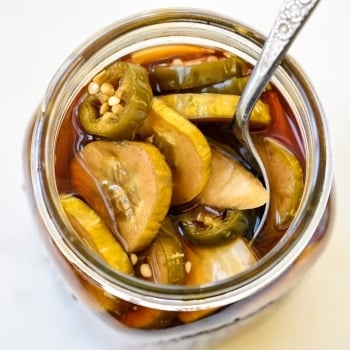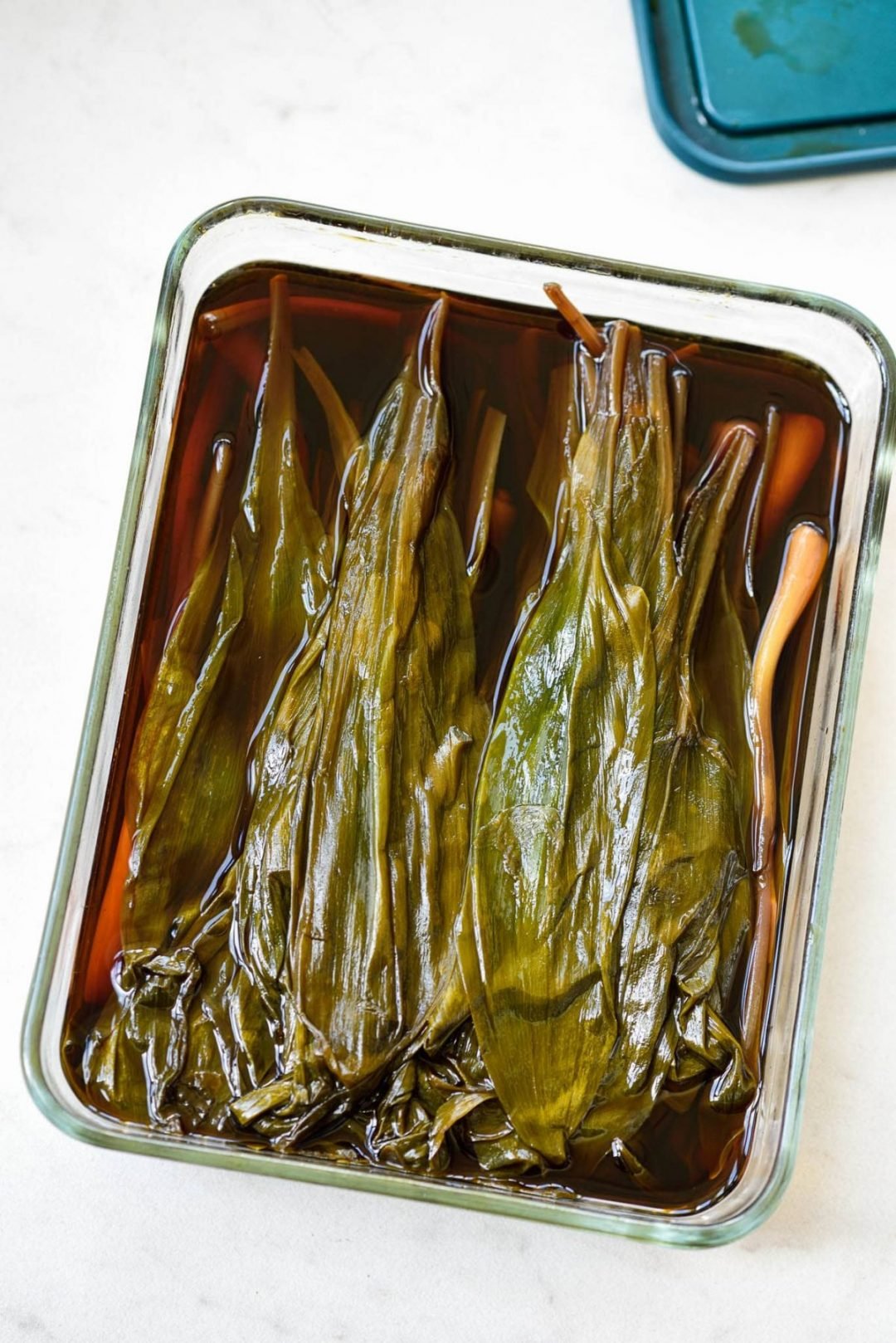Vegetable pickles made with a simple brine with 3 ingredients — soy sauce, vinegar and sugar! These Korean pickles are quick, delicious and crunchy!

Salty, sweet, tangy and crunchy Korean pickles, anyone? Pickling is a food preservation process, and different cultures have different techniques and flavorings. In Korea, vegetables pickled in soy sauce are highly popular. You can use this simple brine with 3 ingredients — soy sauce, vinegar and sugar — for quick pickling of any vegetables!
These pickles go very well with any Korean meal, especially with grilled meat dishes. They will wake up your appetite and brighten your meal.
Collectively called jangajji (장아찌), Korea has a wide variety of pickles. Some are pickled in soy sauce, and some are pickled in doenjang (Korean fermented soybean paste) or gochujang (Korean red chili pepper paste).
In the old days, the salt content for pickling was very high for a long shelf life. With the invention of refrigeration and availability of vegetables all year round, that’s no longer necessary. We now simply enjoy pickles for their appetizing savory taste.
This mild soy sauce pickling is similar to “quick pickling” or “refrigerator pickling” in America. No canning required! And it’s meant to be kept in the fridge. You can start eating them the next day or so, but they will get better with a few days in the brine.
In case you wonder, these pickles are not fermented because of the vinegar in the solution. For fermented Korean traditional cucumber pickles, see my oiji recipe.
How to make a brine for Korean pickles
Easy peasy!
- Clean and cut vegetables into bite size pieces any way you want. Pack them in jars.
- Add water, soy sauce, and sugar to a pot, and bring it to a boil.
- Add vinegar.
- Pour the hot brine over the vegetables.
- Cool, close the lid, leave it out a day or two, and refrigerate.
No, the hot brine will not cook the vegetables, but shocking them with hot water will help create crunch on the outside.
The ratio of water, soy sauce, sugar and vinegar is a matter of preference. I’ve used the same ratio I’m sharing here for many years, and it’s exactly how I like it. Not that salty, not too sweet, and not too vinegary! So, here’s my golden ratio:
| Water | Soy Sauce | Sugar | Vinegar |
| 2 cups | 1 cup | 1/2 cup | 1/2 cup |
If you want saltier, sweeter or more vinegary pickles, simply adjust any of the three ingredients to taste, keeping the water amount the same. The additional liquids will also yield more brine so you’ll need more veggies.
This recipe yields enough brine to pickle vegetables packed in two 32-oz jars and maybe a little more depending on how packed your vegetables are in the jars. Don’t worry about finding 32-oz jars. You can use smaller jars or even Pyrex containers. Remember we’re not canning for these quick pickles.
If you want to add more flavor, add a small piece of dashima (dried kelp) to the brine before boiling. Or, use vegetable broth instead of water.
I know some of you wonder which sugar and/or vinegar to use. Any sugar and any clear vinegar are fine. However, remember the acidity level of vinegar varies widely depending on the type.
Which vegetables to pickle
As you can see from the photos, I pickle quite a few different vegetables using the same brine. The only thing I’d do differently is pickled garlic for which I use a 2-step process.
This recipe calls for cucumbers, onions and jalapenos, but those are simply guidelines. You can pickle only one of these vegetables if you want, or use entirely different vegetables.
Depending on the season, my other favorites are Korean radish, Chayote, maneuljjong (마늘쫑, garlic scapes), kkaennip (깻잎, perilla leaves), and ramps. Ramps are very similar to Korean mountain/wild garlic called myungi (명이), which is highly popular as pickles.
Chayote, which is not a common vegetable in Korea, is a brilliant find by some Koreans in America for pickling. I first tried chayote jangajji at a Korean restaurant many years ago. Its taste, as well as the texture, is somewhere between cucumber and white radish, which is great for incredibly crispy pickles.
How long will these Korean pickles keep?
Again, these pickles are made to be kept in the fridge. Don’t worry even if you forgot to put in the fridge right away. They are fine at room temperature for 2 to 3 days. The salt level, vinegar and even sugar keep them from any harmful bacteria to grow during that time.
These pickles will keep well for up to 4 weeks in the fridge.
To keep it longer, you can pour out the brine into a pot and boil it for a few minutes. You can do this after 3 or 4 days of pickling at which time the vegetables have released their water content and diluted the brine. This time, cool it, pour back over the pickles, and return to the fridge.
What to do with leftover soy sauce brine
The vegetable infused soy brine is delicious. You can use it as a dipping sauce or use it in cooking or marinating. Just remember it’s been diluted and contains vinegar. Better yet, you can add more soy sauce, sugar and vinegar, boil, and make more pickles.
More Pickle Recipes
Oiji (Cucumber pickles)
Maneul jangajji (picked garlic)
For more Korean cooking inspirations, follow along on YouTube, Pinterest, Twitter, Facebook, and Instagram.

Ingredients
For 2 32-oz jars
- 2 pounds cucumbers (Kirby pickling cucumbers, Korean cucumbers) or any other vegetables of choice
- 1 medium onion
- 4 to 5 green chili peppers or jalapenos
For the brine
- 1 cup soy sauce
- 1/2 cup sugar
- 1/2 cup vinegar (any clear type such as rice vinegar, white vinegar, etc.)
Instructions
- Clean and cut the vegetables into bite size pieces, any way you want.
- Pack the vegetables in jars or glass containers.
- Add 2 cups of water to a small pot along with 1 cup of soy sauce and 1/2 cup of sugar. Bring it to a boil, and gently boil for 2 to 3 minutes over medium heat, until the sugar is dissolved. Turn the heat off, and pour in 1/2 cup of vinegar. Adjust to taste if necessary.
- Pour the hot brine over the vegetables. If the vegetables are tightly packed in the jar, you don't need to weigh it down. However, make sure all the vegetables are submerged in the brine.
- Close tightly with a lid, and leave it out at room temperature for a day or 2. Then refrigerate. The pickles can be eaten the next day or so of pickling, but they will taste better as they mature.
- Optional: To keep the pickles longer, you can pour out the brine into a pot and boil it for a few minutes. You can do this after 3 or 4 days of pickling at which time the vegetables have released their water content and diluted the brine. This time, cool it and pour back over the pickles before refrigerating.

































